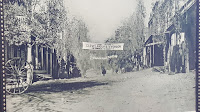Our new book is out: The Bridge at El Djem
I’m very excited to announce that we’ve published our first work of historical fiction: The Bridge at El Djem. It’s part of a World War II adventure
series inspired by real events. Particularly involving the combat history of
the 509th PIB. All characters are, of course, composites or strictly
a fictional construct of the author. That being said, the author’s notes at the
end of the book lists the nonfiction works where the ideas for the plot of the
story came from. The Bridge at El Djem is available on Amazon in print, Kindle,
or Kindle Unlimited. Here’s a synopsis from the back cover of the book:
WWII Action in North Africa
The Kraut on point was probably only twenty yards away
when he turned and signaled to his men to spread out to the left and right. As
soon as his head started to turn, Bell raised his Thompson submachine gun.
After letting out a breath and thinking, here we go, he squeezed the trigger.
The rest of the squad opened up instantly…
Tunisia, 1942
Paratroopers Lieutenant Jack Bell and lead scout Corporal
Roland “Rube” Roubideaux might be the only survivors out of their platoon after
a failed mission to blow up a bridge behind enemy lines. Now they are going
back to finish the job, tagging along with a detachment of British SAS desert
commandos. But it seems the operation isn’t that simple. One of Bell’s own men
doesn’t appear to be who he says he is and the British captain leading the raid
might have a secret mission all his own.
Some folks might be wondering why I took a break from
nonfiction. Actually, I’ve been asked that very question in different ways. I
thought I’d address those questions here:
Why Historical Fiction?
I enjoy reading historical fiction, war and military
fiction, WWII fiction, or whatever people choose to label the genre. As a history
teacher, I’ve learned how works of fiction can educate as well as entertain. Michael
Shaara’s The Killer Angels was a life-changing book for me when I read
it the first time. That book really fired up my passion for military history.
More specific to The Bridge at El Djem, the plan is to write
a series of adventure stories within the background of different chapters in The
Boldest Plan is Best: The Combat History of the 509th Parachute
Infantry Battalion during WWII. My hope is that readers of the fiction stories
will then explore the real history. And maybe the history fans will give the
fiction a try.
What was the process?
Well, it turns out that writing fiction is hard. It took a
year to produce the first book in the series. At one point it got put in a
drawer, then pulled out again and taken back to the drawing board. I also spent
a lot of time learning how to write fiction by reading a lot about writing,
taking a fiction writing class, and of course, when all else fails, learn by
doing.
What’s the next project and when can we expect it?
I’m already well into the next story in the series. The
background is the Geronimos’ jump behind the lines at Avellino, Italy. The
Avellino Jump will be available later this spring. I’ll post a preview
soon.
I’ve been asked about the status of the nonfiction project
on the combat history of the 503rd PIR during WWII. It is long
overdue but not forgotten. More news on that project soon.
















































